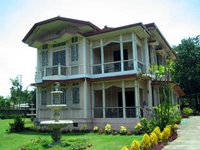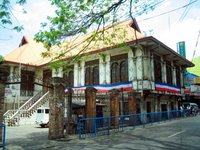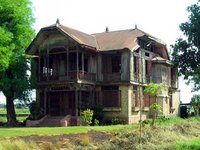 I missed the Pulilan Carabao Festival today. The parade started at 2 p.m. but I was still voting here in San Fernando, Pampanga. I guess though, with the elections set today, the celebration in Pulilan would not be as grand as last year. So I was content with looking at photos taken by Sidney Snoeck from last year's festival, held annually every May 14 in honor of San Isidro Labrador whose feast day is tomorrow. (Photos courtesy of Sidney Snoeck)Don't miss the happenings in Quezon tomorrow which include the Pahiyas Festival in Lucban, Mayohan in Tayabas, and Agawan in Sariaya. I also heard the celebration in Gumaca is another must visit. From May 17 to 19, the streets of Obando, Bulacan will be alive with devotees doing the traditional fertility dance.
I missed the Pulilan Carabao Festival today. The parade started at 2 p.m. but I was still voting here in San Fernando, Pampanga. I guess though, with the elections set today, the celebration in Pulilan would not be as grand as last year. So I was content with looking at photos taken by Sidney Snoeck from last year's festival, held annually every May 14 in honor of San Isidro Labrador whose feast day is tomorrow. (Photos courtesy of Sidney Snoeck)Don't miss the happenings in Quezon tomorrow which include the Pahiyas Festival in Lucban, Mayohan in Tayabas, and Agawan in Sariaya. I also heard the celebration in Gumaca is another must visit. From May 17 to 19, the streets of Obando, Bulacan will be alive with devotees doing the traditional fertility dance.Technorati Tags:
pulilan,
bulacan,
philippines,
carabao festival,
carabao,
festival,
festivals,
culture,
travel blog
It’s been quite a while since I’ve been on a road trip. And today’s itinerary was a spur of the moment decision. Since we needed more photos for the 2007 HCS calendar which would feature capitols, city halls and municipios; and since Gemma said Baliuag has a historical one, I decided to make a detour into northeastern Bulacan on the way back to Manila from Pampanga. I exited in Pulilan and passed by the town proper (the church is right along the national highway). There were several charming bahay na bato and chalets along the way. Maybe next year I’ll try to watch the Carabao Festival from May 14 to 15, again held in honor of San Isidro Labrador. This festival is also held in San Isidro, Nueva Ecija and Angono, Rizal.
I exited in Pulilan and passed by the town proper (the church is right along the national highway). There were several charming bahay na bato and chalets along the way. Maybe next year I’ll try to watch the Carabao Festival from May 14 to 15, again held in honor of San Isidro Labrador. This festival is also held in San Isidro, Nueva Ecija and Angono, Rizal. From Pulilan, I was off to Baliuag to take a photo of their old municipio which is now a museum. I like the way Baliuag is planned, with a glorieta in the middle of town. The church and convento are well-preserved. In front of the church is a grand monument to Dr. Jose Rizal complete with a pair of sphinxes on either side which is so art deco.
From Pulilan, I was off to Baliuag to take a photo of their old municipio which is now a museum. I like the way Baliuag is planned, with a glorieta in the middle of town. The church and convento are well-preserved. In front of the church is a grand monument to Dr. Jose Rizal complete with a pair of sphinxes on either side which is so art deco. The old municipio is a few meters away along the road to San Miguel. After taking some snapshots, and since I felt like exploring some more, I decided to visit San Miguel de Mayumu since the municipio there was also built during the Spanish colonial period. It however wasn’t the main attraction of the town.I’ve been there several years back and the elegant colonial homes were just splendid! But I was surprised to find many of them in a state of decay, including the three-storey Victorian Cake House which is always featured in coffee table books on Philippine architectural heritage.
The old municipio is a few meters away along the road to San Miguel. After taking some snapshots, and since I felt like exploring some more, I decided to visit San Miguel de Mayumu since the municipio there was also built during the Spanish colonial period. It however wasn’t the main attraction of the town.I’ve been there several years back and the elegant colonial homes were just splendid! But I was surprised to find many of them in a state of decay, including the three-storey Victorian Cake House which is always featured in coffee table books on Philippine architectural heritage.
 There is a twist to the third floor since this was rare in the bahay na bato. According to the story, "a macho farmer married the landowner's daughter. To out-do his father-in-law, the farmer built the tallest house in the area: so that the father, on passing the threshhold, had to look up to his son-in-law! The third level had a massive ballroom where the elite would throw balls as entertainment between sugar crops."
There is a twist to the third floor since this was rare in the bahay na bato. According to the story, "a macho farmer married the landowner's daughter. To out-do his father-in-law, the farmer built the tallest house in the area: so that the father, on passing the threshhold, had to look up to his son-in-law! The third level had a massive ballroom where the elite would throw balls as entertainment between sugar crops." San Miguel is one of the few well-preserved towns which have yet to be declared by the National Historical Institute. Yes, the NHI board has yet to declare San Miguel, Bulacan and many other heritage towns! And while these historians sit down and take their time, many centuries-old homes are going down, taken for granted by the very institution mandated to protect them.
San Miguel is one of the few well-preserved towns which have yet to be declared by the National Historical Institute. Yes, the NHI board has yet to declare San Miguel, Bulacan and many other heritage towns! And while these historians sit down and take their time, many centuries-old homes are going down, taken for granted by the very institution mandated to protect them. How sad it was to see a well-preserved heritage town in such a sorry state. I wonder why the Provincial Government of Bulacan, which I have known to be a staunch advocate of culture and the arts, is allowing these houses to decay and remain in such a state of neglect given that San Miguel’s ancestral homes are among the showcases of the province?
How sad it was to see a well-preserved heritage town in such a sorry state. I wonder why the Provincial Government of Bulacan, which I have known to be a staunch advocate of culture and the arts, is allowing these houses to decay and remain in such a state of neglect given that San Miguel’s ancestral homes are among the showcases of the province? On the way back, I took a photo of the Ilusorio House in San Ildefonso which was along the highway. Aside from its outstanding architectural features, the house stands as a poignant reminder of the horrors of the Second World War where women from an entire barangay (Mapanique, Candaba) were locked and raped repeatedly by their Japanese captors. These wives, mothers and daughters, collectively known as the Malaya Lolas, had lost their husbands, fathers and sons who were tortured and massacred by the Japanese Imperial Army. Sigh!It was also suggested that I pass by San Rafael to check out the old houses. There were some nice ones but not as much as San Miguel. Since I was in San Rafael, might as well visit the church in Angat which was featured in the book of Fathers Javellana and Galende, Great Churches of the Philippines.
On the way back, I took a photo of the Ilusorio House in San Ildefonso which was along the highway. Aside from its outstanding architectural features, the house stands as a poignant reminder of the horrors of the Second World War where women from an entire barangay (Mapanique, Candaba) were locked and raped repeatedly by their Japanese captors. These wives, mothers and daughters, collectively known as the Malaya Lolas, had lost their husbands, fathers and sons who were tortured and massacred by the Japanese Imperial Army. Sigh!It was also suggested that I pass by San Rafael to check out the old houses. There were some nice ones but not as much as San Miguel. Since I was in San Rafael, might as well visit the church in Angat which was featured in the book of Fathers Javellana and Galende, Great Churches of the Philippines. The exterior was charming! But the interior was just shocking, an excessive use of gold leaf! Just to make things clear, what was done inside the Angat Church was a renovation and not a restoration. For it to be a restoration, it must approximate the original interior of the church.The new ceiling murals were just too loud and modern for the old colonial charm of this church. As I told a friend (the one who did the interior was also a friend), you don’t put opulence when it was previously not there. In fact, the elegance of the Angat Church was in its simplicity, now erased by a rampage of gold leaf.One must not impose his style on an old church. That goes for priests, parish pastoral councils and the architects and interior designers they hire to renovate them, who most of the time go overboard with decorations and details. We must leave old churches as they are because these are testaments to the craftsmen and artisans who designed them.Additions should not overpower the original design. I wonder how these architects and interior designers would feel if a hundred years from now, their works would be eradicated by future architects and interior designers who like them impose their style on previous masterpieces.Anyway, enough said. From Angat, it was off to Manila. I took the longer, more scenic route via Norzagaray. The foothills of the Sierra Madre offered a relaxing view. But there were eyesores as well, quarrying plants and their towering machinery. Sigh! The drive was quite long thanks to the slow traffic as I neared Metro Manila. It would take me to San Jose del Monte City, North Caloocan and finally, Fairview where traffic management was horrible! Mayor Belmonte should fire his traffic enforcers and ban undisciplined jeepney drivers. Hmmmm... there wouldn't be any jeeps left then! Hehe! I had driven a total of seven hours! And now it's time for me to rest.
The exterior was charming! But the interior was just shocking, an excessive use of gold leaf! Just to make things clear, what was done inside the Angat Church was a renovation and not a restoration. For it to be a restoration, it must approximate the original interior of the church.The new ceiling murals were just too loud and modern for the old colonial charm of this church. As I told a friend (the one who did the interior was also a friend), you don’t put opulence when it was previously not there. In fact, the elegance of the Angat Church was in its simplicity, now erased by a rampage of gold leaf.One must not impose his style on an old church. That goes for priests, parish pastoral councils and the architects and interior designers they hire to renovate them, who most of the time go overboard with decorations and details. We must leave old churches as they are because these are testaments to the craftsmen and artisans who designed them.Additions should not overpower the original design. I wonder how these architects and interior designers would feel if a hundred years from now, their works would be eradicated by future architects and interior designers who like them impose their style on previous masterpieces.Anyway, enough said. From Angat, it was off to Manila. I took the longer, more scenic route via Norzagaray. The foothills of the Sierra Madre offered a relaxing view. But there were eyesores as well, quarrying plants and their towering machinery. Sigh! The drive was quite long thanks to the slow traffic as I neared Metro Manila. It would take me to San Jose del Monte City, North Caloocan and finally, Fairview where traffic management was horrible! Mayor Belmonte should fire his traffic enforcers and ban undisciplined jeepney drivers. Hmmmm... there wouldn't be any jeeps left then! Hehe! I had driven a total of seven hours! And now it's time for me to rest.
 I missed the Pulilan Carabao Festival today. The parade started at 2 p.m. but I was still voting here in San Fernando, Pampanga. I guess though, with the elections set today, the celebration in Pulilan would not be as grand as last year. So I was content with looking at photos taken by Sidney Snoeck from last year's festival, held annually every May 14 in honor of San Isidro Labrador whose feast day is tomorrow. (Photos courtesy of Sidney Snoeck)
I missed the Pulilan Carabao Festival today. The parade started at 2 p.m. but I was still voting here in San Fernando, Pampanga. I guess though, with the elections set today, the celebration in Pulilan would not be as grand as last year. So I was content with looking at photos taken by Sidney Snoeck from last year's festival, held annually every May 14 in honor of San Isidro Labrador whose feast day is tomorrow. (Photos courtesy of Sidney Snoeck)







